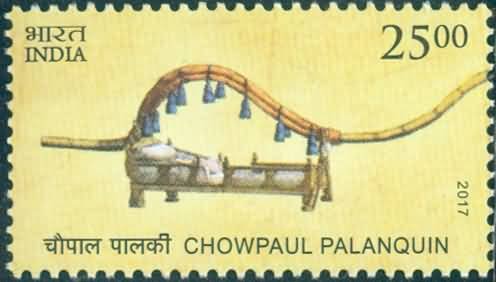Chowpaul Palanquin

Technical Data
| Stamp Set | Means of Transport |
|---|---|
| Date of Issue | March 25, 2017 |
| Denomination | Rs. 25 |
| Quantity | 3,000 |
| Perforation | 13 |
| Printer | India Security Press, Nashik |
| Printing Process | Wet Offset |
| Watermark | No Watermark |
| Colors | Multicolor |
| Credit (Designed By) | Sh. Brahm Prakash |
| Catalog Codes |
Michel IN 3130 Yvert et Tellier IN 2821 Stanley Gibbons IN 3284 |
| Themes | Transport |
Introduction
The Chowpaul Palanquin was one of the earliest and most graceful modes of human transport used in India. Considered a symbol of dignity, comfort and prestige, it carried people across towns and villages long before wheeled transport became common. It reflects the rich cultural heritage of India’s ancient mobility system.
Meaning and Origin
The word Palanquin or Palki originates from the Sanskrit word “Palanki”, meaning a bed or couch. The Chowpaul Palanquin derives its name from the four bearers (chau meaning four) who carried it. Designed for comfort and privacy, it served as an essential mode of transport particularly for women, nobles and dignitaries.
Design and Features
The Chowpaul Palanquin was usually made of wood and crafted with elegance. Its key features included:
- A covered seating or resting area for the passenger
- Decorative doors on both sides
- Soft bedding and cushions for comfort
- A long pole attached lengthwise to facilitate carrying
- Usually carried by four bearers, sometimes six for longer journeys
The palanquin varied in decoration depending on the status of the person it carried.
Use in Social and Cultural Life
The Chowpaul Palanquin held deep cultural relevance in Indian society. It was commonly used for:
- Weddings: The bride often travelled to her marital home in a beautifully decorated palanquin.
- Travel of noblewomen: It ensured both comfort and privacy.
- Ceremonial occasions: Royalty and landlords used ornate palanquins to mark special events.
Its presence in literature, art and folklore highlights its emotional and cultural significance in Indian traditions.
Historical Importance
References to palanquins appear in ancient Indian epics including the Ramayana. Over centuries, the Chowpaul Palanquin evolved as the most recognized form of personal transportation in India. It remained the primary mode of dignified travel until the early 20th century, after which rickshaws and modern vehicles gradually replaced it.
Decline and Legacy
With the advent of bicycles, rickshaws and later motorized transport, the palanquin slowly faded from regular use. Today, it survives mostly as a traditional ceremonial element, especially in wedding rituals and cultural performances.
Despite becoming a relic of the past, the Chowpaul Palanquin continues to be remembered as a symbol of:
- Graceful mobility
- Cultural heritage
- Social customs and traditions
Conclusion
The Chowpaul Palanquin not only served as an early means of personal transport but also represented social status, elegance and cultural values. It remains a cherished part of India’s historical journey of transport, reminding us of a time when travel was both artistic and regal.
